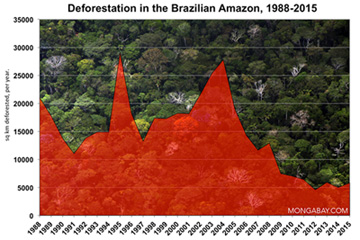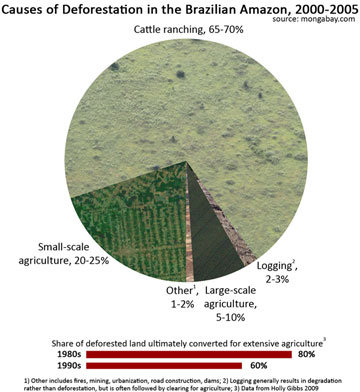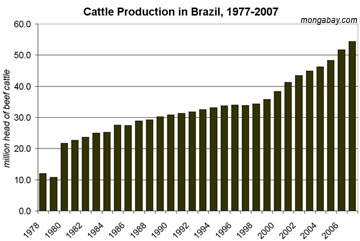|
The Impact of Growing Demand for Beef on the Amazon Rainforest in Brazil
Center for International Forestry Research
April 2, 2004
Free of Mad Cow and Foot-and-Mouth, Amazonian Cattle Find Favor Abroad; Study Says Dramatic Growth in Exports Primary Culprit in Huge Rainforest Losses in Brazil
Brazil's spectacular and growing success as a prime exporter of beef-volume of exports abroad have increased more than fivefold in the last six years-is responsible for much of the recent spike in the destruction of the Amazon rainforest, according to a study released today by one of the world's leading forestry research organizations. In a report summarizing their work*, the researchers demonstrate a strong link between the dramatic deforestation rates, which the Brazilian government is expected to announce shortly, and the growth in exports that have caused a massive surge in the Brazilian Amazon's cattle population-from 26 million head in 1990 to 57 million in 2002.
The report, Hamburger Connection Fuels Amazon Destruction-issued by the Center for International Forestry Research (CIFOR), a Future Harvest Center based in Bogor, Indonesia-suggests that the jump in the worldwide demand for Brazilian beef has been brought on by several factors, among them concerns regarding the threat of mad cow disease in several other cattle-producing countries.
|

DEFORESTATION IN BRAZIL: 60-70 percent of deforestation in the Amazon results from cattle ranches while the rest mostly results from small-scale subsistence agriculture. Despite the widespread press attention, large-scale farming (i.e. soybeans) currently contributes relatively little to total deforestation in the Amazon. Most soybean cultivation takes place outside the rainforest in the neighboring cerrado grassland ecosystem and in areas that have already been cleared. Logging results in forest degradation but rarely direct deforestation. However, studies have showed a close correlation between logging and future clearing for settlement and farming. [Portugu�s | Espa�ol]
Deforestation by state
|
"This research provides the first substantial data to support recent speculation about the role international demand for Brazilian beef is playing in Brazil's skyrocketing deforestation rate," says David Kaimowitz, Director General of CIFOR and one of the report's authors. "In a nutshell, cattle ranchers are making mincemeat out of Brazil's Amazon rainforests."
In the analysis of their data, Kaimowitz and his colleagues report that the Brazilian cattle industry has also benefited from a recent devaluation of the Brazilian currency, a decrease in the nation's incidence of foot-and-mouth disease, and, possibly, fears of avian flu, which may have led the public to choose beef over chicken.
"Brazil's success in combating foot-and-mouth disease may be good news for the cows, but it is bad news for the forest," Kaimowitz said.
Between 1990 and 2001 the percentage of Europe's processed meat imports that came from Brazil rose from 40 to 74 percent. Markets in Russia and the Middle East are also responsible for much of this new demand for Brazilian beef. With much of Brazil's beef recently certified free of foot-and-mouth disease, beef from Brazil is considered preferable to beef from other regions where cases of mad cow disease have been identified.
|
Causes of deforestation in the Amazon
|
Cattle ranches
| | 60-70% |
|
Small-scale, subsistence agriculture
| | 30-40% |
|
Large-scale, commercial agriculture
| | 1-2% |
|
Logging, legal and illegal
| | 2-4% |
|
Fires, mining, urbanization, road construction, dams
| | 2-4% |
Selective logging and fires that burn under the forest canopy commonly result in forest degradation, not deforestation. Therefore these factor less in overall deforestation figures.

The above pie chart showing deforestation in the Amazon by cause is based on the median figures for estimate ranges. Please note the low estimate for large-scale agriculture. Between 2000-2005 soybean cultivation reesulted in a small overall percentage of direct deforestation. Nevertheless the role of soy is quite significant in the Amazon. As explained by Dr. Philip Fearnside, "Soybean farms cause some forest clearing directly. But they have a much greater impact on deforestation by consuming cleared land, savanna, and transitional forests, thereby pushing ranchers and slash-and-burn farmers ever deeper into the forest frontier. Soybean farming also provides a key economic and political impetus for new highways and infrastructure projects, which accelerate deforestation by other actors."
|
"As recently as 1995, Brazil exported less than US$500 million dollars of beef. By 2003, only eight years later, Brazil was exporting three times as much, US$1.5 billion dollars," according to the authors of the report, who cited data provided by the U.S. Department of Agriculture. "Between 1997 and 2003, the volume of exports increased more than fivefold, from 232,000 to nearly 1.2 million metric tons in Carcass Weight Equivalent. Meanwhile, domestic beef consumption, which for decades has been responsible for the sector's expansion, developed slowly. For the first time ever, the growth in Brazilian cattle production-80 percent of which was in the Amazon-was largely export driven."
The Brazilian government's Space Research Institute (INPE) is expected to shortly issue satellite images that show the Amazon rainforest disappearing at an alarming rate. This will continue the trend reported in 2003, when INPE released figures showing a 40 percent increase over the 2002 figure. Preliminary indications suggest the soon-to-be-released figures will be equal to or greater than the extremely high figure of 2.5 million hectares reported last year.
The total area of forest lost in the Amazon rose from 41.5 million hectares in 1990 to 58.7 million hectares in 2000. In just ten years, the region lost an area of forest twice the size of Portugal. Most of it has become pasture, according to the CIFOR report.
"Although the last few years have witnessed a great deal of justifiable concern about the expansion of soybean cultivation into the Amazon, that still explains only a small percentage of total deforestation," according to the authors. They also note that logging contributes indirectly to deforestation, but is "much less important than the growth of cattle ranching."
The report suggests that the following factors have led to the recent dramatic increase in the cattle population of the Amazon:
" Currency Devaluations: Between December 1998 and December 2002, the value of the Brazilian real against the dollar went from 1.2 reais per dollar to 3.6 reais per dollar, doubling the price of beef in reais and creating "a huge incentive for ranchers to expand their pasture areas." At the same time, the dollar price of Brazilian beef fell, which made it more competitive on the world market.
" Trends in Livestock Diseases: Until 1998, no Brazilian state had been certified free of foot-and-mouth disease (FMD), which prevented the country from exporting beef to many international markets. "Now, however, the situation has changed," note the report's authors. "Since 2003, the states of Mato Grosso, Rond�nia, and Tocantins have been declared FMD-free, and can sell their beef any where they want. These states account for over 60 percent of the [Amazon's] cattle herd. By 2005, the Brazilian government expects the entire country to be free of disease. These changes have increased beef prices in the Amazon, and hence the incentive to deforest."
" Other Changes in the Amazon: The Amazon has undergone a dramatic expansion in its roads and electrical networks, and has seen an increase in efficient and modern facilities such as slaughterhouses, meatpacking, and dairy plants. Ranching is made even more because the price of land is low. "These prices remain very low in part because farmers find it easy to illegally occupy government land without being prosecuted, and to deforest areas much greater than the 20 percent of their farms currently permitted by law," the report says.
On March 15, Brazil's President Luis In�cio (Lula) da Silva announced a major new "Action Plan to Prevent and Control Deforestation in the Legal Amazon." The plan commits the government to spending 394 million reais (approximately US$135 million) on activities designed to reduce deforestation. These include better planning for land use, greater enforcement of laws regarding deforestation and the illegal occupation of government lands, improved monitoring of deforestation, more detailed reviews of public infrastructure investments, greater support for indigenous territories and community forestry, increased support for sustainable agriculture, and greater control over credit for ranchers.
"The government's approach goes in the right direction, but unless urgent action is taken, the Brazilian Amazon could lose an additional area the size of Denmark over the next 18 months," said Benoit Mertens, one of the authors of the report and a researcher with CIFOR. Mertens is currently a visiting scientist in the Forest Department at CIRAD (the French Agricultural Research Center for International Development).
"Any steps to effectively tackle Brazil's deforestation problem will require high-level attention, and a number of additional measures, more funds, and greater coordination between and within the key ministries," Benoit said. "The international and domestic market forces currently promoting the cattle-driven deforestation described in CIFOR's report are much stronger than ever. Even with the most determined policy response, it might be hard to decisively curb deforestation. To limit the negative impact on Brazilian rainforests will require a massive effort."
The CIFOR report recommends the following four policy areas as vital to the sustainable future of Brazil's Amazon forests:
|

Cattle production in Brazil, 1977-2007. Chart based on USDA data. Click to enlarge.
|
" Prevent the grabbing of land. The government's focus on land tenure regulation in its new Action Plan is fully justified. Making progress in this area will require substantial political will and funding and more efficient institutional mechanisms for keeping ranchers from illegally occupying government lands.
" Restrict road projects outside already developed regions. The plans for new infrastructure, in particular road construction and improvement projects, must be revised or reversed if deforestation really is to receive a high priority. Extensive studies on deforestation underline not only the absolutely key role roads play, but also the difficulty in implementing measures to control land speculation and deforestation close to roads.
" Formally register government-owned lands as National Forests (FLONAS) to stop the further incursion of ranching into these areas. For this purpose, the Brazilian government should prioritize forested areas that are in the greatest danger of being converted to pasture.
" Provide economic incentives to maintain land as forest. Brazil is already planning for a compensation program to promote more intensive and eco-friendly agriculture (PROAMBIENTE), but it should also experiment with direct payments for forest conservation.
To implement the measures needed to effectively reduce deforestation will require more resources than the Brazilian government has so far been able to commit. Unfortunately, given the current recession in the Brazilian economy, it will be very difficult for the government to devote more funds to save the Amazon. The international community must be prepared to provide additional funds to support the Brazilian government efforts, according to the authors of the CIFOR report.
While this report is largely the result of research undertaken by CIFOR scientists, researchers from other agencies have also contributed significantly. These agencies include CIRAD (the French Agricultural Research Center for International Development), Embrapa (Brazil's Agricultural Research Corporation), IBAMA (Brazil's State Agency for Environment and Renewable Natural Resources), and INPE (Brazil's Space Research Institute, which is part of the Ministry of Science and Technology).
Related articles
Brazil's grasslands could replace food production of American heartland
Today when Brazil is mentioned in the same sentence with "agriculture," people often first envision the Amazon rainforest giving way to soybean plantations and cattle farms. While the Amazon is being converted for such purposes, the cerrado, a vast area of savanna-like grasslands covering more than 20% of the country's surface area, is increasingly under threat as farmers from the United States and Europe are setting their sights on the biome's sizeable agricultural potential.
Can cattle ranchers and soy farmers save the Amazon?
John Cain Carter, a Texas rancher who moved to the the Brazilian state of Mato Grosso 11 years ago and founded what is perhaps the most innovative organization working in the Amazon, Alian�a da Terra, believes the only way to save the Amazon is through the market. Carter says that by giving producers incentives to reduce their impact on the forest, the market can succeed where conservation efforts have failed. What is most remarkable about Alian�a's system is that it has the potential to be applied to any commodity anywhere in the world. That means palm oil in Borneo could be certified just as easily as sugar cane in Brazil or sheep in New Zealand. By addressing the supply chain, tracing agricultural products back to the specific fields where they were produced, the system offers perhaps the best market-based solution to combating deforestation. Combining these approaches with large-scale land conservation and scientific research offers what may be the best hope for saving the Amazon.
Globalization could save the Amazon rainforest
The Amazon basin is home to the world's largest rainforest, an ecosystem that supports perhaps 30 percent of the world's terrestrial species, stores vast amounts of carbon, and exerts considerable influence on global weather patterns and climate. Few would dispute that it is one of the planet's most important landscapes. Despite its scale the Amazon is also one of the fastest changing ecosystems, largely as a result of human activities, including deforestation, forest fires, and, increasingly, climate change. Few people understand these impacts better than Dr. Daniel Nepstad, one of the world's foremost experts on the Amazon rainforest. Now head of the Woods Hole Research Center's Amazon program in Bel�m, Brazil, Nepstad has spent more than 23 years in the Amazon, studying subjects ranging from forest fires and forest management policy to sustainable development. Nepstad says the Amazon is presently at a point unlike any he's ever seen, one where there are unparalleled risks and opportunities. While he's hopeful about some of the trends, he knows the Amazon faces difficult and immediate challenges.
News index | RSS | Add to MyYahoo!
Advertise on mongabay.com
With tens of thousands of daily visitors, mongabay.com is one of the world's most popular environmental science web sites. Advertising information.
| |
|
MONGABAY.COM
Mongabay.com seeks to raise interest in and appreciation of wild lands and wildlife, while examining the impact of emerging trends in climate, technology, economics, and finance on conservation and development (more)
CONTENTS
|